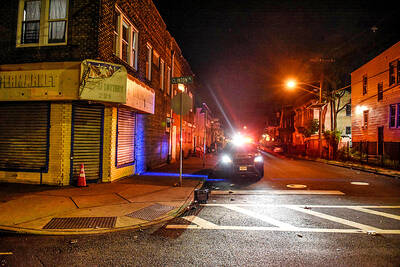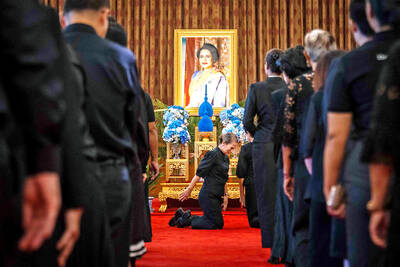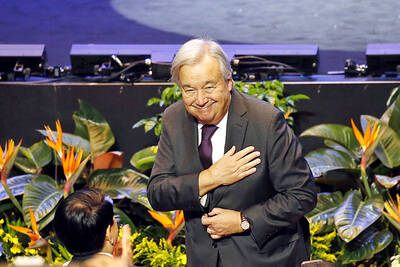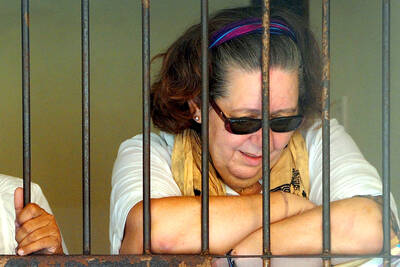The hill above Heyri Art Valley, an artists' village under construction about four miles south of the demilitarized zone between North and South Korea, is still marked by trenches from the 1950-53 Korean War. In one of these, the Korean artist Cho Duck-hyun has placed resin model heads that suggest the remains of South Korean soldiers excavated from the hillside.
Nearby, a trail of Korean characters in rusted steel traces its way to the top of the hill, where steel panels with cut-out characters -- all part of a sculpture by Lim Ok-sang -- form a poem dedicated to a South Korean spy who was sent to the North in the 1970s and never returned.
The themes of war and partition, here on the world's most fortified border, find further elaboration inside Heyri Art Valley's Jung Han-sook Memorial Hall, where two Swedish artists have installed the mock embassy of Elgaland-Vargaland.
A mythical country
This is a mythical country made up of the frontiers of the world's divided territories. The flag is white with a red zigzag, and the artists offer passports and ministerial positions to anyone who applies.
The installations are part of "DMZ-2005," a month-long exhibition of works by 20 Korean and 20 foreign artists that opened on June 25 to mark the 55th anniversary of the start of the Korean War.
Organized by DMZ-Korea, a nonprofit group founded by Yu Yeon-kim, a New-York based South Korean curator, and financed primarily by the government of Kyonggi province, the artworks explore the ramifications of borders and division around the world, with special attention to Korea.
"I wanted to have artists from around the world come and see the location to discuss and question this boundary," Kim said. "I'm interested in artists having a conversation to rethink and renew the focus on these areas, politically and culturally, from different perspectives."
The Kyonggi authorities supported the exhibition as part of a larger effort to spur development in this region and encourage better inter-Korean relations, in keeping with the South's "sunshine policy" of engagement with the North.
"The DMZ is the result and symbol of confrontation, conflict, division of the country and war," said the province's governor, Sohn Hak-kyu, in an interview after the exhibit's opening ceremony.
symbol of peace
"But we want to change this area of the country into a symbol of peace, reconciliation and unity," he added.
One participating artist, Kang Hong-goo, commented on the unlikelihood of an exhibition at this site.
"Fifteen years ago no one would have dreamed of this place," said Kang, whose black-and-white panoramas of a film set recreating Seoul during the 1910-45 Japanese occupation recall an earlier period of trauma in Korean history. "It's too close to the DMZ. Sometimes I think Koreans have a `fear of war' syndrome."
The limitations of South Korea's reconciliation with the North are reflected in Ham Yang-ah's video of Mount Kumgang, a tourist retreat in the North built by South Korea's Hyundai Group.
The conglomerate's inter-Korean business division, Hyundai Asan, sponsored Ham's trip to the resort, where she shot footage of her nighttime journey to the village from a horse-drawn carriage. The video, titled Tourism in Communism, conveys the claustrophobia of this enclave totally isolated from ordinary life in the North.
The intense surveillance along the demilitarized zone forms a backdrop for the "Evidence Locker" project devised by the American artist Jill Magid in collaboration with the police of Liverpool, England. Every day for a month last year, Magid telephoned the city's video surveyors and asked them to record her at various sites and help guide her through the center of town with her eyes closed.
She then had the tapes released to her as "evidence" and edited them for an installation that dramatizes the prevalence of video surveillance in many urban centers around the world while diffusing its threatening associations and turning it into a tool of intimacy.
3,000 flowers
At the observatory atop nearby Mount Odu, where visitors can look across the demilitarized zone into North Korea, the South Korean artist Ahn Sung-keum has hung a large balloon bearing a new flag she created for the two Koreas.
The flag shows a united Korea filled with 3,000 flowers -- the number symbolizing the length of the Korean Peninsula in traditional measurements.
In clear weather, the observatory can be seen from the North, and the balloon was meant to be visible to North Koreans. The exhibition, however, fell squarely within the rainy season.

DOUBLE-MURDER CASE: The officer told the dispatcher he would check the locations of the callers, but instead headed to a pizzeria, remaining there for about an hour A New Jersey officer has been charged with misconduct after prosecutors said he did not quickly respond to and properly investigate reports of a shooting that turned out to be a double murder, instead allegedly stopping at an ATM and pizzeria. Franklin Township Police Sergeant Kevin Bollaro was the on-duty officer on the evening of Aug. 1, when police received 911 calls reporting gunshots and screaming in Pittstown, about 96km from Manhattan in central New Jersey, Hunterdon County Prosecutor Renee Robeson’s office said. However, rather than responding immediately, prosecutors said GPS data and surveillance video showed Bollaro drove about 3km

‘MOTHER’ OF THAILAND: In her glamorous heyday in the 1960s, former Thai queen Sirikit mingled with US presidents and superstars such as Elvis Presley The year-long funeral ceremony of former Thai queen Sirikit started yesterday, with grieving royalists set to salute the procession bringing her body to lie in state at Bangkok’s Grand Palace. Members of the royal family are venerated in Thailand, treated by many as semi-divine figures, and lavished with glowing media coverage and gold-adorned portraits hanging in public spaces and private homes nationwide. Sirikit, the mother of Thai King Vajiralongkorn and widow of the nation’s longest-reigning monarch, died late on Friday at the age of 93. Black-and-white tributes to the royal matriarch are being beamed onto towering digital advertizing billboards, on

POWER ABUSE WORRY: Some people warned that the broad language of the treaty could lead to overreach by authorities and enable the repression of government critics Countries signed their first UN treaty targeting cybercrime in Hanoi yesterday, despite opposition from an unlikely band of tech companies and rights groups warning of expanded state surveillance. The new global legal framework aims to bolster international cooperation to fight digital crimes, from child pornography to transnational cyberscams and money laundering. More than 60 countries signed the declaration, which means it would go into force once ratified by those states. UN Secretary-General Antonio Guterres described the signing as an “important milestone,” and that it was “only the beginning.” “Every day, sophisticated scams destroy families, steal migrants and drain billions of dollars from our economy...

Indonesia was to sign an agreement to repatriate two British nationals, including a grandmother languishing on death row for drug-related crimes, an Indonesian government source said yesterday. “The practical arrangement will be signed today. The transfer will be done immediately after the technical side of the transfer is agreed,” the source said, identifying Lindsay Sandiford and 35-year-old Shahab Shahabadi as the people being transferred. Sandiford, a grandmother, was sentenced to death on the island of Bali in 2013 after she was convicted of trafficking drugs. Customs officers found cocaine worth an estimated US$2.14 million hidden in a false bottom in Sandiford’s suitcase when